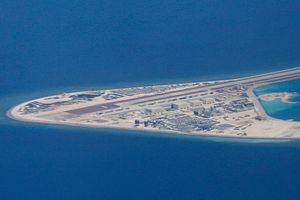China appears to have deployed long-range anti-ship cruise missiles and air-defense missiles to the Spratly Islands, providing the islands with offensive reach for the first time. The move dashes hopes across the region that China would refrain from, or at least limit, its militarization of the extensive bases it has built on reclaimed coral reefs in the heavily disputed islands.
Intelligence sources told CNBC News that China had placed supersonic YJ-12B anti-ship cruise missiles and HQ-9B anti-air missiles on Fiery Cross, Subi, and Mischief Reefs in the Spratly Islands. China’s Ministry of Foreign Affairs tried to downplay the significance of the deployment, but the White House Press Secretary said that China would face consequences for the missile emplacements and its continued militarization of its Spratlys features, without elaborating on what those might be.
New Missiles More Threatening than Earlier Deployments
China occupies seven features in the Spratly Islands, and since 2013, it has reclaimed over 3,000 acres of land to build military bases and port facilities on. Fiery Cross, Subi, and Mischief Reefs are the three largest islands China has reclaimed and are home to the most extensive facilities, including command and control, sensor arrays, runways capable of accommodating every military aircraft in the PLA inventory, hardened aircraft shelters, bunkers for fuel and munitions, and emplacements for missile batteries.
China previously deployed short-range missiles and point-defense systems like anti-aircraft guns and close-in-weapons-systems to the islands, designed to defeat incoming missiles. Statements from China’s Ministry of Foreign Affairs that the island build-ups and point-defense systems did not constitute “militarization” were a rhetorical strain on the term, but it is true that those earlier systems had mostly defensive utility and were broadly non-threatening.
A Chinese Ministry of Foreign Affairs spokeswoman addressed this new deployment with the same justification it has used for those earlier short-range systems, that they were “national defense facilities.” To reiterate the defensive narrative, the spokeswoman said that no other countries needed to worry about the new anti-ship and anti-air missiles unless they had an “invasive intention.”
This is true to a point, and was likely a jab directed at the United States, which has prepared studies and plans in recent years that depict conducting offensive amphibious operations against Chinese-occupied islands in the South China Sea. But while anti-ship cruise missiles and anti-air missiles can play a defensive role, unlike the point-defense systems deployed earlier, they are capable of offensive force projection as well. The earlier point-defense systems’ short ranges meant they could engage incoming missiles fired at the bases they were installed on but could not reach the warships or aircraft that fired them, so foreign warships and aircraft operating even in close proximity to the Spratlys did not need to be concerned by them.
However, the long ranges of the YJ-12 and HQ-9 missiles allow them to engage warships and aircraft far beyond the horizon. That range means they can be used for defense by engaging ships and aircraft that are attacking the Spratlys, but also that they can also project control of the sea and airspace around them against ships and aircraft merely traversing the skies around them. Estimates for the YJ-12’s range vary from 160 to 250 nautical miles, though some claim it can reach nearly 300, and the HQ-9B’s range is believed to be around 100 nautical miles. Their placement on Subi, Mischief, and Fiery Cross Reefs means that China could theoretically engage ships in most of the southern half of the South China Sea, and engage aircraft flying anywhere in the vicinity of the wider Spratly Islands.
China’s Spratlys Bases Now Unambiguously “Militarized”
President Xi Jinping’s 2015 statement on militarizing the Spratly Islands in the South China Sea has often been mischaracterized as a pledge or promise, when his language – that China did not “intend” to militarize the features it occupied – was diplomatically ambiguous enough to leave room for the option later. Earlier this year, official statements from China’s Ministry of Foreign Affairs and editorials in state papers foreshadowed that China might deploy more substantial forces to the Spratly Islands, ostensibly in response to threat from U.S. warships and plans conducting freedom of navigation operations in their vicinity. Given the non-confrontational nature of those presence operations, however, China is more likely using them as pretext for buildups they intended anyway.
Before the new deployments were revealed, Admiral Philip Davidson, newly confirmed to be head of the U.S. Pacific Command, reported to Congress in May that China appeared to have completed its bases in the Spratly Islands, and that they only lacked deployed forces on them. Once that happened, he assessed that China would be able to use the bases to challenge the United States’ presence in the region, and concluded that China could use the bases to overwhelm any of its neighbors in the South China Sea, and control the region in all scenarios short of war with the United States.
If these missile systems remain on China’s Spratlys bases, no amount of diplomatic rhetoric will placate other South China Sea countries and extra-regional powers like the United States, Japan, and Australia. It seems likely that China will gage the reaction to this deployment to assess whether, or at least how quickly, it can deploy even more capable force-projection systems to the islands, like fighter and bomber aircraft, and conventional ballistic missiles capable of striking ships and bases at even greater distances, even beyond the South China Sea.

































